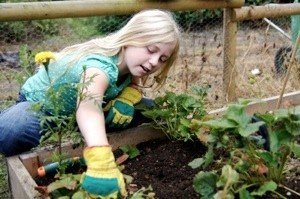
The expression "prevention is the best medicine" certainly applies to gardening, especially to vegetable gardening, where a few minor problems can quickly grow large enough to ruin your entire crop. Once your garden is in and growing, performing the following maintenance tasks will keep garden problems to a minimum.
In gardening, what you don't know can hurt you. Get in the habit of taking daily walks around your garden. Not only will you learn to notice and appreciate the subtle changes occurring in your plants as they grow, but you'll learn to spot signs of trouble early, before they escalate into major problems.
When and how much to water and how much your garden needs depends on a lot of factors: local weather, the type of crops you're growing, each crop's stage of development, soil drainage, etc. As a general rule, crops growing in early to mid summer should receive at least 1 inch of water per week. This can come from rainfall, irrigation systems, or a combination of both. From mid to late summer, as temperature rise and plants grow larger in size, you may find that those same crops need even more water.
If you start your plants in nutrient-rich soil (amended with lots of compost), your crops will probably not need additional feeding during the growing season. Too much fertilizer can be as detrimental to vegetables as not enough. Crops that can usually get by with less fertilizer include beans, peas, radishes, watermelons, and turnips. Crops that tend to be heavy feeders, which may need supplemental nutrients in poorer soil include members of the cabbage family, tomatoes, sweet corn, beets, carrots, onions, celery, and potatoes. A pre-season soil test is really the only way to know for sure if you're coping with nutrient deficiencies. If your plants need a quick boost, consider top dressing the soil with compost or using compost tea.
Here are some basic signs to watch for:
Remove weeds while they are small. This prevents them from establishing deep root systems and keeps them from going to seed. Small frequent weeding sessions make will make the task seem more manageable.
Over time, any mulch added near the start of the season will naturally start to decompose and release nutrients back into the soil. Add new mulch as needed to suppress weeds, keep the soil cool, help retain moisture, and keep your garden looking attractive.
As garden crops grow and start to bear fruit, make sure to provide them with adequate support. Redirect stems while they're still small to keep them inside cages and on trellises. Use coffee cans, nylon slings, or wood scraps to elevate squash and melons off the ground. This will keep them clean and dry (help prevent rotting), protect them from animals, and allow them to develop a uniform shape.
Crops sown from seed should be thinned as soon as seedlings are big enough to handle. Some crops, especially root crops like carrots, beets, radishes, and turnips, may need thinning more than once depending on their stage of development. Look on the back of your seed packets to find out the recommended spacing for each crop.
If you planted potatoes, you need to continue hilling up soil around your plants as they grow. This encourages them to produce long stems and more potatoes. It also keeps developing potatoes from being exposed to light. Use soil or mulch to keep hills mounded up at least 12 inches high.
If birds and bugs have been a problem in the past, use netting or row covers over your crops to prevent further damage. If you see insects or spot early signs of insect damage, use a garden insect guide to correctly diagnose the bug and the problem before you take action. This is important for two reasons:
There are no absolute rules when it comes to harvesting your vegetables, but in general, the best flavor is usually captured when crops are harvested just prior to reaching maturity. If you're going to be away from home when some of your crops near maturity, arrange for a friend or neighbor to do the harvesting for you in exchange for a portion of the crop.
Don't forget to record what is happening in your garden throughout the season. Write down planting, germination, flowering, and harvest dates; the type of bugs you see, weather conditions, crop yields, etc. Jotting down a sentence or two each day will help you repeat successes and avoid failures again next year.

About The Author: Ellen Brown is an environmental writer and photographer and the owner of Sustainable Media, an environmental media company that specializes in helping businesses and organizations promote eco-friendly products and services.
Add your voice! Click below to comment. ThriftyFun is powered by your wisdom!
Great advice. I'm just getting into the whole vegetable garden concept and there is a learning curve! One big lesson is to not be afraid of moving things around to stake them, as they will thrive more for the effort.
Here's more fun on vegetable gardens.
www.oldhouseweb.com/
Hello Ellen, Can you tell me what the tiny holes in many of my only tall tomato plant could be and how to heal the plant before it takes over the whole plant?
Add your voice! Click below to comment. ThriftyFun is powered by your wisdom!